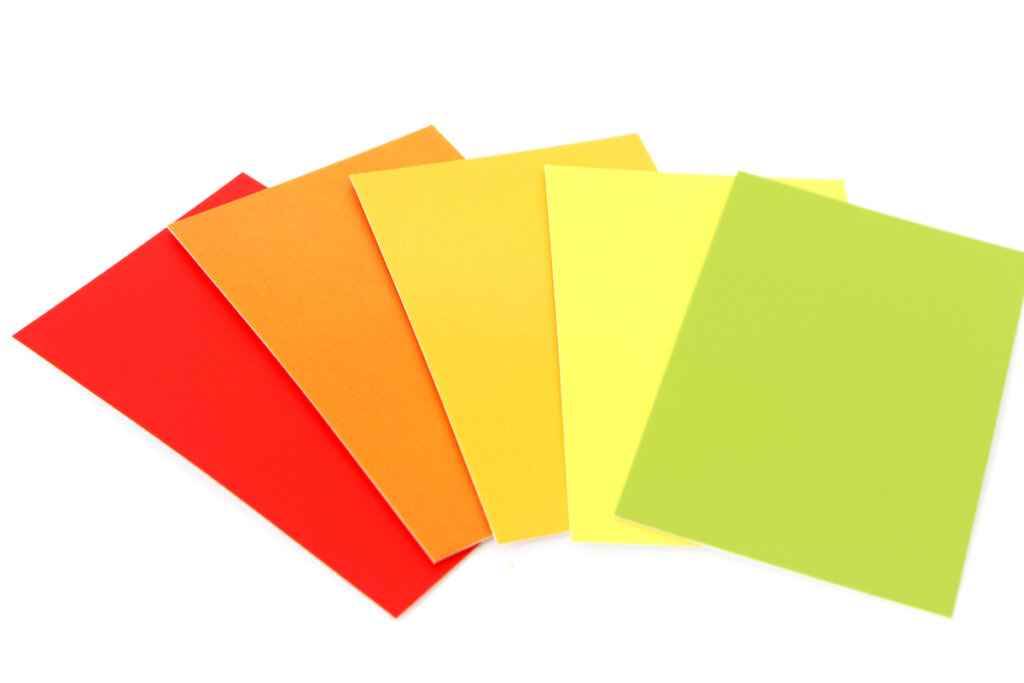The Lüscher Color Test

Exploring personality is one of the most fascinating tasks in the field of psychology. It not only serves to detect conflicts and disorders, perform diagnoses, and implement treatments, it’s also extremely useful in the field of human resources and personnel selection. Indeed, it can help employers choose candidates in an optimal way. The Lüscher eight-color test is one of the most widely used options in this regard.
Psychologists use different methods and instruments for exploring personality. For example, interviews, tests, questionnaires, and practical exercises. In consultation, standardized psychometric tests are usually the psychologists’ first choice. This is due to their reliability and scientific validity.
For various reasons, such as poor standardization, difficult interpretation, sensitivity to the circumstances in which they’re administered, and questionable scientific validity, projective tests are used in far fewer cases. The Lüscher color test is one such test.

What is the Lüscher color test?
This test is a projective test and is, therefore, loaded with subjectivity. Its value lies in that it allows the psychologist to obtain information that would otherwise be difficult to access. For example, certain internal conflicts, fantasies, or defense mechanisms. These types of elements are difficult to recognize and verbalize. Therefore, projective tests can create the necessary scenario for this.
Swiss psychotherapist Max Lüscher developed the Lüscher color test in 1947. He designed the test to evaluate the psychology and emotionality of people based on their preference for certain colors. His theory was that each different color tone presented in the test was related to specific moods and needs.
This is the objective component of the test, since globally, the same chromatic stimulation will generate the same response in all individuals. However, there’s also a subjective component in that some people may feel a preference for certain colors and reject others. Uniting these two variables in interpretation leads to some curious and interesting conclusions.
How does it work?
The application of the test is simple. Generally, psychologists use a reduced version that’s based on the original. This is the test we’ll talk about today. The individual is presented with eight cards, each a different color. They’re then asked to order them according to their preference.
It’s important that when ordering them, the individual only focuses on color stimulation. In other words, the sensations that the color generates. They shouldn’t choose by connection. For example, choosing blue because it reminds them of the sea. Nor should they choose due to personal preference. It’s the sensations that the color evokes in them that should guide their choice.
Interpretation of the Lüscher color test
When interpreting the results, psychologists take into account both the meanings associated with each color and the positions chosen by the individual.
The basic colors (red, blue, yellow, and green) are expected to be in the first positions. That’s because they symbolize fundamental psychological needs. In the same way, black, brown, violet, and gray should be placed in the last places. If not, this could indicate certain negative trends.
Meanings associated with colors
To better understand the interpretation of the test, here are the meanings related to each color:
- Blue. It represents the need for satisfaction and affection. It symbolizes tranquility, passivity, and rest. If it’s in the first position, it indicates that the person seeks and needs serenity and harmony.
- Green. It signifies the need for self-assertion. It’s related to the instincts of self-preservation and the need to defend oneself. If it occupies a very low position, it can indicate dependency problems towards others.
- Red. It refers to external action, the need to act, conquer, or obtain. Its position indicates if the individual wants more or less activity in their life.
- Yellow. It symbolizes optimism and projection for the future. In principle, the higher its position, the more capable the individual will be in facing life situations energetically.
- Violet. It represents transformation but also instability. It’s also related to vanity (in the first position) or sensitivity and empathy if you occupy central positions.
- Gray. It’s the color of neutrality and indifference. These qualities are present in the individual if it tops the list and absent if it’s in last place.
- Brown. It symbolizes bodily and biological needs. The higher it appears on the list, the greater the person’s desire to satisfy them. The lower on the list, the more repression and rejection it represents.
- Black. It signifies aggressiveness and confrontation. Depending on its position, it shows whether the individual wants it, is currently exercising it, or rejects and represses it.

Validity and reliability of the Lüscher color test
As it’s a projective test, its interpretation is rather subjective. In fact, as a rule, years of experience are necessary for a professional to be able to obtain valuable information when administering this type of test.
For this reason, these resources can be extremely dangerous in the hands of professionals who don’t have the necessary skills and caution to use them. For example, a misinterpretation could result in a therapy being built on foundations that have nothing to do with the patient’s problem. In this case, there would always be harmful consequences. At the very least, it could mean a delay in launching an adequate intervention.
All cited sources were thoroughly reviewed by our team to ensure their quality, reliability, currency, and validity. The bibliography of this article was considered reliable and of academic or scientific accuracy.
- Aguirre, L. (2006). Estudio comparativo entre el test abreviado y el test completo de los colores. Límite. Revista Interdisciplinaria de Filosofía y Psicología, 1(14), 159-174.
- Muñoz, L. Test de Lüscher. Basado en los Talleres del Test de Lüscher, dictados por el Psic. Nevio Del Longo y en el Seminario realizado por Max Lüscher en el país.
- Palomero Pescador, José Emilio y Teruel Melero, María Pilar y Fernández Domínguez, María Rosario (2009). El poder del optimismo. Revista Interuniversitaria de Formación del Profesorado, 23 (3), 15-22. [Fecha de Consulta 15 de Diciembre de 2021]. ISSN: 0213-8646. Disponible en: https://www.redalyc.org/articulo.oa?id=27419066002
This text is provided for informational purposes only and does not replace consultation with a professional. If in doubt, consult your specialist.








